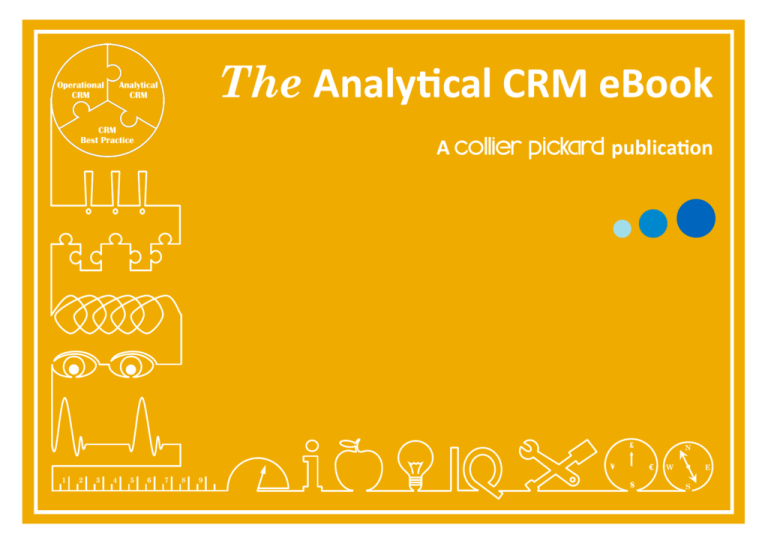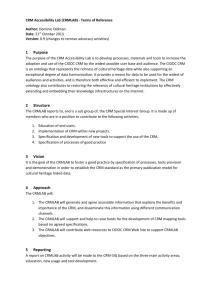
Operational
CRM
The Analytical CRM eBook
Analytical
CRM
CRM
Best Practice
A
publication
£
¥
1
2
3
4
5
6
7
8
9
N
€
$
W
E
S
Analytical CRM eBook v. 2.0.
All material in this eBook is copyright ©
Collier Pickard Ltd 2013.
www.collierpickard.co.uk
info.collierpickard.co.uk/blog
crm@collierpickard.co.uk
+44 (0)1959 560410
“If you see technology as a way to sell more stuff, then you’re probably going to
end up destroying value for your business. But if you see technology as a way to
improve the customer’s life, then you’ll probably sell more stuff.”
Tom Peters—Re-imagine! Business Excellence in a Disruptive Age.
1
Foreword
In 2009, we published the first edition of
The CRM Pocket Book, subtitled
“What works ... What doesn’t”.
The pocket book includes a chapter entitled
CRM components, which identifies Operational CRM,
Analytical CRM and CRM Best Practice as components in
the world of CRM. It also identifies Social CRM as an
emerging component for CRM (at that time) – but Social
CRM has come of age since 2009 and now merits comment
in its own right.
This eBook is one of a series, which examines in more detail
the following:
Operational CRM
Analytical CRM
and
Social CRM
The eBooks in the series also examine CRM Best Practice
within the context of each of the CRM components.
2
Creating KPIs of this type is a straightforward process and
can be totally automated by CRM technology.
But you need to have decided to collect the data before you
started!
It would be very time consuming to generate the statistics
after the event … and inaccuracies may be rife.
Food for thought
So analytics in the world of CRM might not be a case of
taking stuff out of the box and rolling it out to your user
community. There may be some planning required before
you start. You may need to know what you want to
measure. And why!
One of our clients – FC Business Intelligence – participated
in a 2011 webinar, organised by The Chartered Institute of
Marketing, The Marketer, and Sage.
It was stated that the organisation measured a
493% return on marketing spend through the successful
application of CRM to their business. Great ROI.
1
2
3
4
5
6
7
8
9
But how did they know this figure so precisely? Well – it’s
because they have analytical capabilities within their CRM
world. They can link the sales figures generated from
specific outbound marketing campaigns back to the
campaign cost. Simple.
3
Operational
CRM
The big picture
For most people CRM means the culture and
practices you adopt to help manage your business –
the job of acquiring, developing and retaining
customers – supported by technology.
A CRM system must therefore have all the attributes
you need for efficiency in marketing campaign
management, sales opportunities development and
customer services (case handling) – Operational CRM.
So where does Analytical CRM fit into the broader
CRM world?
Analytical
CRM
CRM
Best Practice
The answer is that Analytical CRM is the conduit to
improving your customer relationship management culture
and the effectiveness of your people who deal directly with
your customers and your markets.
Analytical CRM provides the insight into what works and
what doesn’t within your Operational CRM – and so
informs improvements in CRM best practice within your
organisation.
Improvements in best practice are, in turn, delivered as
changes in Operational CRM procedures and culture – and
so the virtuous circle continues.
Analytical CRM is the key which unlocks the information
you need to continually adapt to customer demands and
shifts in markets.
4
So what is Analytical CRM?
Analytical CRM covers those parts of your customer
relationship management world which inform and raise
calls to action.
In this context, inform may mean data visualisation.
And it may mean decision support.
Calls to action may mean that “light bulb moment” for the
individual.
All this must be designed to make you more responsive to
your customers and the markets in which you operate. It
must help you achieve your top level goals.
Or it may mean proactive use of data in your CRM world to
alert you to changes or exceptions to the norm.
So let’s examine data visualisation, decision support, light
bulb moments, alerts and exceptions one piece at a time.
5
Data visualisation
These days there’s a tendency to think graphics and
dashboards when data visualisation crops up. Great – but
that’s not the whole story.
In our opinion, best practice in Operational CRM will create
tangible data visualisation as an automatic by-product of
individuals just going about their day-to-day jobs. In this
context, the simple list is a form of data visualisation. If
customers, prospects, sales opportunities, campaigns,
customer service cases, call lists and the like are presented
by the CRM system as lists, rather than forms which must
be paged through, then the CRM system user can easily
identify like events, matching conditions and anomalies by
eye. No reporting needed.
And lists work best for data visualisation when the data is in
a row and column format which can be filtered and
sorted by column headings – just like an Excel spread sheet.
Lists in operational CRM represent best practice in
presenting data and information to the individuals using
the system – the customer touch-points within your
organisation.
6
White spaces
Company
Town
Country Account manager Status
Next action
AB Services
Slough
UK
Contract Haulage
Bristol
Orly Generale
Paris
PM Consultants
Phil G
Qualified
Presentation to management
Phil G
New lead
Arrange meeting
France
Pierre L
Qualified
Proposal
Aberdeen
UK
Maria B
Qualified
Proposal
Ventura
Edinburgh
UK
Zoom Labs
Birmingham
123 Industries
London
UK
New lead
Gary J
New lead
Arrange meeting
Simon V
Qualified
Presentation to management
It’s not difficult to see the value of white spaces in this list,
this data grid. No-one is assigned to follow up the new lead
in Edinburgh.
Data visualisation is not confined to the world of
dashboards, Excel pie charts, Crystal Reports graphics, BI
doughnuts and the like. White spaces speak volumes in
data visualisation and they are available as simple
configurations inside operational CRM. Very low cost. Very
high value.
You just need an operational CRM system which allows the
configuration of information in row and column format.
Simple and effective data visualisation and decision
support.
And what if you can’t build these grids inside your
operational CRM system, or you can’t easily manipulate the
data columns with sub-totals and totals? Then export the
data grid to Excel and continue your analytical CRM there –
always remembering that best practice dictates that you
should only ever be a couple of clicks away from your next
action within your CRM world. Export to Excel would
therefore best be configured as a simple icon within the
operational CRM interface.
7
Dashboards
Dashboards and graphics are now the norm within CRM
software. Some are home-grown by the software author;
some have embedded business intelligence (BI) tools.
The key to effective dashboards is to make them
context-sensitive and relevant to the individual. Graphics
deliver the most value when they allow drill-down to the
underlying data – when they lead you to the detail of the
thing that caught your eye in the chart.
Using dashboards in Analytical CRM requires an
understanding that customer information must be accurate
and up to date. This requires a level of CRM maturity. You
need a culture within your organisation which makes
individuals realise that other people will make decisions
and take actions assuming that the dashboard is correct.
Without this culture, without an overt understanding that
information in CRM is vital to the way the business is
managed, people are likely to do one of two things:
Make a bad decision
Spend time – waste time – ratifying the accuracy of
information which came from others
Neither of these makes sense! You need a team culture
which understands this.
8
Decision support
Analytical CRM is a great decision support tool. Within
your business there will be a variety of metrics which help
you work out where you are today and what you need to
do to get to where you want to be tomorrow.
N
Performance against your top level goals, your strategy, is
often expressed in financial terms using Key Performance
Indicators (KPIs), which come from ERP or financial
accounting. So how can Analytical CRM be a decision
support tool in this area of business management?
The answer lies in your definition of the hygienic KPIs which
will measure the day to day performance against your
tactical plans – the small pieces of the jigsaw which build
up to the success defined by the top level goals.
W
E
S
Decision support in Analytical CRM therefore takes on an
operational aspect:
Is my conversion rate increasing?
Is my customer satisfaction rating above the line?
Is the enquiry rate satisfactory?
Are service calls handled within agreed levels?
Has customer attrition reduced?
Are call rates on plan?
9
This is where BI tools have a place in Analytical CRM. The
ability to associate data from disparate systems and
display it in a relevant form for the individual responsible
for acting the KPI analysis – this is at the very core of BI
design. It can lead to “light bulb moments”!
Business intelligence
Business intelligence tools (BI) have an increasingly
important role in Analytical CRM. This is because the
authors of operational CRM systems can only build in
analysis of information within the software’s own database.
Out-of-the-box dashboards, graphics and reports can only
examine the data within their control.
So, what if one of your KPIs is (say) a measure of average
aged debt in days against targets set for customers in
categories Tier 1, Tier 2 and Tier 3? In this KPI, the aim is to
learn from the analysis and design account management
tactics, by customer category, which improve the speed at
which invoices are settled. But how is this possible when
the first part of the analysis is held in financial accounting
and the second in operational CRM?
10
Light bulb moment
We’ve all had them! The sudden realisation that
transforms the way you do things from here on in. The
flash of inspiration which leads to an immediate
improvement in this or that.
We helped one of our clients – emap – to use an
in-memory BI tool to associate customer call data and order
revenues to generate some enlightening insights into
telesales best practices. The BI tool pulls data from the
phone switch, associates the number called to a record in
CRM and associates this customer ID to revenue stats held
in a sales order processing system. Telesales calls, by
individual, by campaign, by date, by time of day, by
duration, by customer category, and so on – all this
information is linked to revenue generation figures. Hidden
sales information unlocked by Analytical CRM.
Another of our clients – Brammer – is unlocking sales data
(revenues, margins, dates) held in ERP, analysing it with
in-memory BI technology and using the graphical
information to educate key account managers. Technology
enabled selling. Analysis to improve customer relationship
management.
11
Alerts
Business Alerts Management. So far our investigation of
analytics and decision support has been confined to the
presentation of information to individuals. Here’s the list,
here’s the graph – you decide!
But there’s another aspect to analytics within CRM – where
the analyses and the decisions are automated. You just get
the call to action – without having to review data lists and
work it out for yourself.
Business alerts can transform analytical CRM within an
organisation. They can positively impact your ability to
improve customer relationships. For example, alerting
you to forthcoming deadlines before the customer action
becomes overdue; alerting you to a KPI which has moved
out of the acceptable range (rather than waiting for you to
find this information at the end of the day or later); alerting
you to a change in status within a key account; and alerting
you to exceptions – things outside the norm.
Alerts can be configured to make standard reporting
proactive – so that the information comes to you at the
right time, in the right format, without you having to click
around and get it yourself.
Alerts save time and can help improve customer
relationships.
£
¥
€
$
12
How much does Analytical CRM cost?
This is another of those “how long is a piece of string?”
questions. The answer is, of course, it depends on the type
of analysis you need for the various customer touch-points
within your organisation. It depends on your tactical
approach to your markets and your customers and the KPIs
you need to measure your progress towards your top level
goals.
At the other end of the spectrum you will need a
sophisticated BI tool which extracts, transforms and loads
data from many disparate systems – digital marketing, SOP,
Accounts Receivable, ERP, Excel spread sheets – builds
graphical displays of associative links, and distributes
dashboards, trends analyses and data drill-down to
countless users around the globe. This will be a costly
approach to analytical CRM, however, it may well deliver a
significant ROI as it helps improve your position in the
market and your relationships with your customers.
At one end of the spectrum, analytical CRM may cost you
nothing. If your CRM deployment includes the right
education, then the CRM users will already understand
their responsibility to maintain accurate, relevant and
timely information inside CRM – then the standard reports
and dashboards (supplied with the system) may be able to
do the rest for you.
13
What works
What doesn’t
Analysing CRM results against your top level goals works …
Empowering your teams with the right information at the right time
works …
Drilling into trends that you haven’t investigated before works …
Producing a few reports and lists doesn’t.
Not sharing your insights doesn’t.
Assuming that everything is fine doesn’t.
Creating data visualisation within CRM works …
Leaving people to work with cluttered screens doesn’t.
“White space” visualisation in lists works …
Having to open multiple screens to verify data doesn’t.
Dashboards which are relevant to individual users works …
Building hygienic KPIs into your CRM structure works …
Creating trends from customer-related measurements works …
Mixing data from multiple sources works …
Encouraging people to share their inspiration from light bulb moments
works …
Automating decisions with Alerts works …
Modifying your best practice rules through analytical review works …
Assuming everyone can work things out from company-level charts
doesn’t.
Measuring performance against financial goals alone doesn’t.
Reviewing snapshot positions alone doesn’t.
Relying on the information captured in CRM alone doesn’t.
Encouraging a rigid workflow culture doesn’t.
Depending on people to remember to check every time doesn’t.
Assuming it works as well as it did on Day 1 doesn’t.
14
About Collier Pickard
Collier Pickard is a leading CRM consultancy for
the mid-market. A niche player.
From our UK base we help organisations align
their CRM culture to the top level goals of their
business ... from start ups to blue chip, global
operations.
Our team of CRM professionals has been
together for nearly 20 years. We have
implemented more than 400 CRM and sales/
marketing systems. This gives us a deep
understanding of best practice – what works
and what doesn’t.
Collier Pickard –
Chosen by small firms for local support
Chosen by multinationals against major
consultancies
Chosen for its depth of knowledge in the
niche market that is CRM
15
The Old Calf House, Chevening Road, Sundridge, Kent TN14 6AB
T: +44 (0) 1959 560410 F: +44 (0) 1959 569364
crm@collierpickard.co.uk
info.collierpickard.co.uk/blog
www.collierpickard.co.uk
© Collier Pickard Ltd 2013. All rights reserved.
16









